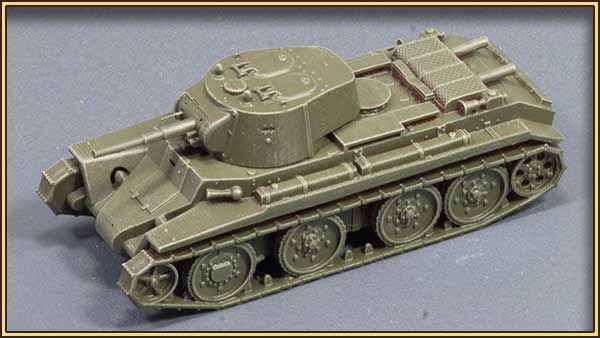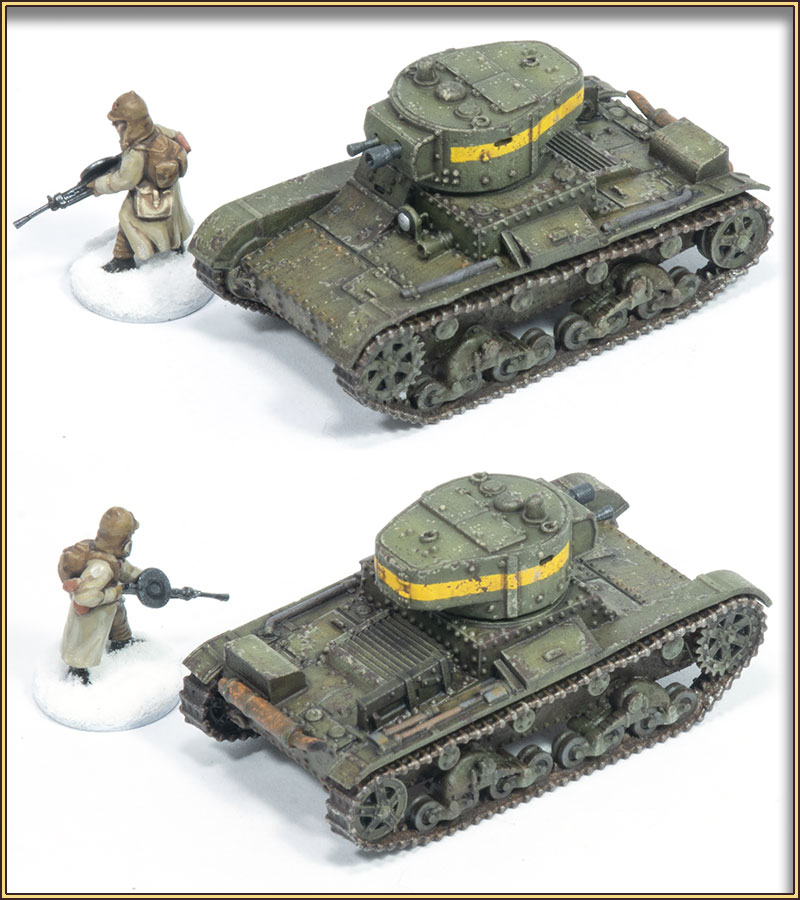The time has come to start decorating my 15mm 3d printed OT-130 (or XT-130, or KhT-130). I was originally going to paint it in winter white, but as it turns out, the Soviets didn't feel the need to indulge in anything as cowardly or effeminate as camouflage when they decided to try to kick the shit out of the Finns, so generic Russian green it is.
Plain green is pretty boring, so I'm bashing the crap out of the paintwork. There's probably a lot more damage than would be very likely, but I think it helps to create a bit of an impression of how shoddy was the construction of these early T-26 variants. Apparently the armour plates were often so poorly fitted that the crew could see light leaking in around them, and bullet fragments finding their way in through the seams was a real danger.
This model is the first one that has presented me with the issue of uncured resin inside pooling and melting away at the shell — I clearly didn't wash out the turret as well as I had thought, and the turret peg was starting to come away from the body. I pulled it right off and hit the innards with a UV torch, and then superglued it back in place; that should take care of the problem this time.
I've now made a little snake-neck UV LED curing wand that is small enough to poke into a 4mm hole, so hopefully this will be adequate to ameliorating the issue in future.
The information I have from the internet suggests that a minute or two with this should cure the resin left on the inside surfaces sufficiently. I don't know how long a 9v battery will last, running one of these LEDs. They're fairly expensive, compared with AA batteries, so if the lifetime is too short I may be better off spending a bit more on a 9v power supply and switch.
I've decided to try a new (to me) experimental method of painting the tracks. It's pretty straightforward.
1) I painted the entire track run in a mid grey, in this case, VMC Medium Sea Grey. I think pretty much any grey would do, though if it's too dark you'd lose a bit of the colour variation the next step gives.
2) Next, I gave it a couple of coats of fairly thin Vallejo Game Effects Dry Rust. I like the grainy texture this stuff leaves.
3) Last, I gave the tracks a dry-brush of VMC Oily Steel. This catches the light and pops out the highlights a bit, while being quite neutral in tone so the brown of the Dry Rust still predominates.
It's not too different from my usual track-painting method, which is to start with a medium brown, splosh on a couple of washes, and dry-brush. I don't know that there's much to choose between them, though I do prefer the texture of the Dry Rust.
The next step is oil-washing. The wash in this case is just raw umber oil paint in white spirit — turpentine can be used, but I find white spirit evaporates faster, and is less likely to leave any oily residue.
I prefer using an oil-based wash to an acrylic one, as I find it wicks along creases better, and it's more manageable — excess colour can be taken back off just with a clean brush, slightly moistened with white spirit. However, if I'm in a hurry I'll still use Citadel and/or Vallejo acrylic washes, as they dry quickly and I can race ahead to the next stage. A white spirit wash needs to sit for half an hour or an hour before proceeding, and leaving it to dry overnight is better, especially if you intend to do any more spirit-based pin-washes.
The white spirit evaporates long before the oil paint is dry, and when the spirit is almost all gone, I can come back in with a brush and do a bit of streaking of the still-soft paint — you can see it very clearly on the glacis.
Paint chipping is my next stage. This is, no doubt, a familiar process to most AFV modellers these days. It's a weathering step that comes and goes in fashion; for a while it seemed like every AFV model represented a machine that had been forty years in the field without access to a paint shop, but people are being a bit more restrained nowadays.
I use a bit of torn foam to apply the "chips" in a semi-random fashion, and I like to glue the bit of foam to the end of a matchstick, to keep my sausage-fingers out of the way. You can do it in a much more controlled way by using a small pointed paintbrush, but that takes a long time and I'm generally too impatient.
My favourite colour for this is Vallejo Panzer Aces Dark Rust, but any dark brown will do. I've seen dark grey used as well, but I prefer brown to represent oxidized metal.
The key here is not to mash the paint-loaded foam hard against the model, or else you end up with big blotches of paint instead of small, discrete patches of chips.
The main focus is on the corners of the model, and areas of high wear, such as where the crew climb in and out of the machine.
After the chips have been applied, I take another step and add highlights to the edges of the chip patches with a light colour. This can be a tint of the vehicle's base paint colour, or a neutral light grey, or in this case I've used VMC German Camo Beige, which is the same colour I used for the initial dry-brushing to bring out the model's surface detail. This gives the chips a bit of three-dimensionality.
You don't have to hit every single speck and chip, but it's a good idea to get all the large areas, and it's best to confine the effect mostly to the lower edges of the chip area, where the broken paint edge would catch the light. I use a lot of thinner in my paint, and a very small pointed brush, but even so, in this small scale I find it very difficult to get an effect that is both subtle and visible.
You can also do this with a sponge, to get chips that have scratched the surface of the paint, but not penetrated right through to the bare metal. I've skipped that on this model.
Something else I haven't done on this model, but which can look good: go in on large areas of high-traffic chipping with a sharp HB pencil, and scribble into the brown-painted areas only. This will give them a metallic sheen, looking more like areas that are being constantly abraded. You don't need (or want) to entirely cover the brown with graphite; you just need enough there to give it a metallic glint.
As with any weathering technique, it's easy to go overboard with this.























